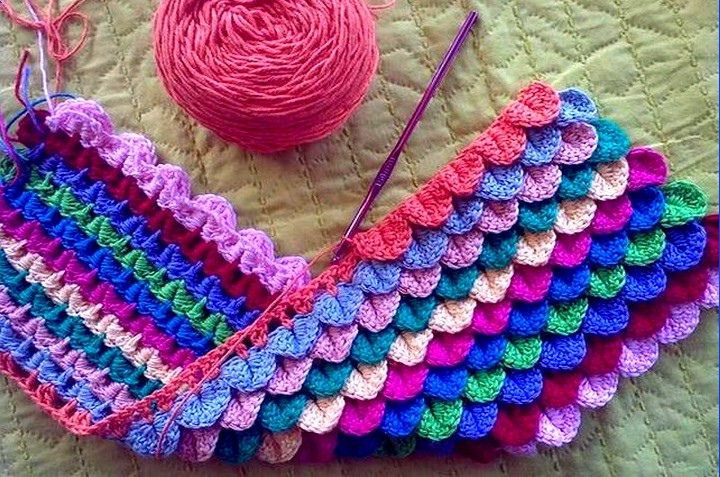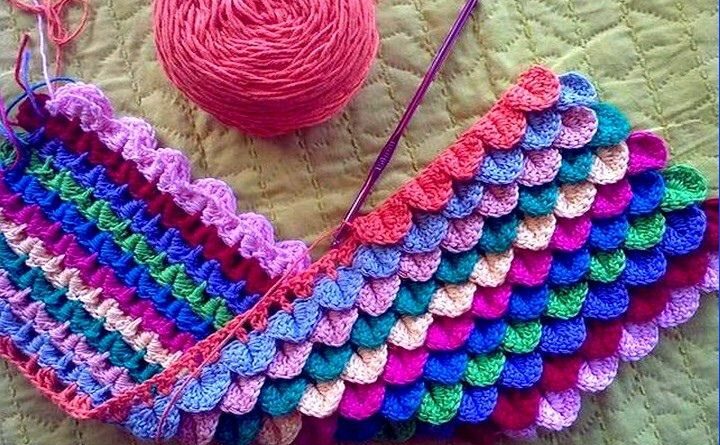Crocodile stitch in crochet
Welcome to another unique crochet creation that is a gateway to creativity and even entrepreneurship. Among the many stitches available, the crocodile stitch stands out for its unique, scale-like texture, making it a favorite among crafters looking to create eye-catching designs. But what if this hobby could become something more? Many crafters have turned their love of crochet into thriving small businesses, selling everything from handmade accessories to personalized home decor. In this article, we’ll explore how mastering the crocodile stitch in crochet can be the first step toward a profitable venture. We’ll review the materials you’ll need, provide a step-by-step tutorial, and share tips on how to monetize your craft.
The crocodile stitch, named for its resemblance to reptile scales, is an advanced crochet technique that creates a layered, textured effect. Unlike traditional stitches, it involves working vertically around a post, forming overlapping “scales” that add depth and dimension to your projects. This stitch is popular for making bags, shawls, and even stuffed animals because of its bold, three-dimensional appearance. While it may seem intimidating at first, with practice it becomes an impressive addition to any crocheter’s skillset.
Beginner crocheters often struggle with uneven scales or gaps between stitches. If the scales are curved, the tension is too tight; loosen your grip a little. If the fabric is wrinkled, you may be skipping foundation stitches—keep counting! Another problem is uneven scales; use stitch markers to mark the starting point of each scale. Don’t be discouraged; even experienced crocheters improve their technique over time. Join online communities or watch video tutorials for visual guidance.

Basic tutorial to learn how to make the crocodile stitch in crochet
Start with a foundation chain (multiple of 4 + 2). Round 1: Single crochet (sc) into the second chain from the hook and work across the row. Round 2: Chain 3 (counts as the first double crochet, or sc), then sc into the next stitch. Now the fun begins — turn your work and work 5 sc around the last sc you made. Turn the “scale” side down and sc into the next two stitches. Repeat this process across the row. The key is to keep the tension even so that the scales lie flat. Practice on a small swatch before tackling larger projects like mittens or hats.
Materials needed to make the crocodile stitch in crochet
Before you get started, you’ll need the right tools. A medium-weight yarn (like worsted weight or DK) works best for beginners, as it’s easier to work with than finer yarns. Pair it with a needle size recommended for your yarn (usually 4.5 mm–5.5 mm). Stitch markers are helpful for keeping track of your rows, and a tapestry needle will help you weave in ends neatly. For a polished finish, consider adding beads or metallic thread to accentuate the scales. Invest in quality materials—the durability and appearance of your finished product may justify higher prices if you decide to sell your creations.
The distinctive texture of the crocodile stitch is ideal for premium products. Consider creating statement pieces like bohemian-style bags, dragon scale gloves, or textured pillow covers. Many crafters underestimate their time. Calculate your costs: materials + (hours worked × fair wage). For example, if a scarf takes 8 hours to make and you pay yourself $15 per hour, plus $10 in yarn, set your price as $130+. Emphasize the intricacy of the stitch in your product descriptions: “Handcrafted with the intricate crocodile stitch—each scale is individually crafted.” Limited-edition or customizable items may command even higher prices.
The crocodile stitch, with its characteristic overlapping scales, did not originate from traditional crochet traditions. While its exact origins are debated, many believe it was popularized in the early 2000s by adventurous crocheters experimenting with 3D textures. Some credit Japanese or Eastern European designers with pioneering the technique, as similar stitches appear in vintage textile art from those regions. Interestingly, the stitch’s rise coincided with the DIY boom on platforms like Ravelry and Pinterest, where crafters shared and refined the pattern.
Fascinating stories through crochet
As demand grows, streamline production. Create patterns for common items to save time. Outsource tasks like photography or shipping if necessary. Teach workshops or sell PDF patterns on Ravelry to earn passive income. Remember: sustainability matters—don’t sacrifice joy for profit. Set boundaries (e.g., “I won’t crochet more than 20 hours a week”) to avoid hobby burnout.
Meet Lena, who started selling crocodile stitch earrings on Etsy as a side hustle. Within a year, she expanded to wholesale orders for boutiques. Or Javier, who monetized his tutorials on YouTube and now earns revenue from ad revenue and pattern sales. Their secret? Consistency and authenticity. They didn’t wait for perfection, and they started small and improved along the way.
The crocodile stitch is a launching pad for entrepreneurial crafters. By mastering this stitch, creating marketable products, and leveraging smart pricing and marketing, you can transform crochet from a hobby into a sustainable source of income. The journey takes effort, but the reward is doing what you love and earning money from it. I hope you can find inspiration in creating amazing pieces with this fun stitch.
So, let’s improve?
If you are looking for a way to start a business and make money with crochet, crocodile stitch in crochet is a great option. So, let’s improve your knowledge even more? How about checking out this link? I would like to point out that the credits for the images and content of the model go to the official website.
Free instructions: Crocodile stitch in crochet


